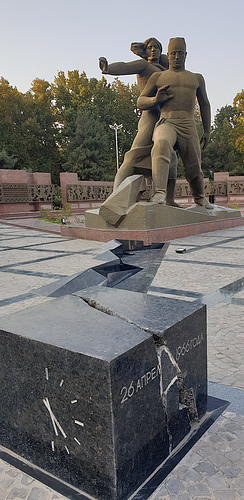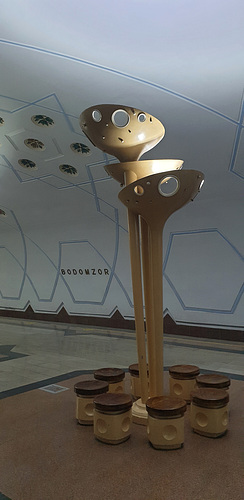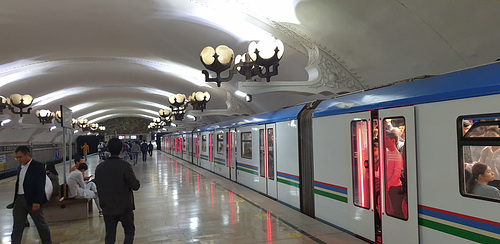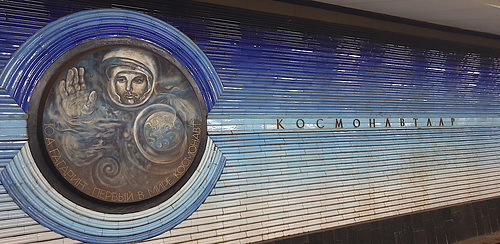11 to 14 Oct, 2022 - Tashkent - (Uzbekistan)
Our final blog entry for this trip (which, depending how you measure, has been 6 weeks in Central Asia, or 21 months since we left Australia). Currently, we're in transit at Istanbul airport, which is pretty much totally the wrong direction from Tashkent to anywhere in Australia, but the flight options out of Central Asia are not bountiful when heading to our Great Southern Land.
So, the end of the trip was very low key back in Tashkent. Some great meals, a few sights, a self created tour visiting many metro statons, and some time to repack our bags. Also, we needed a bit more time each day as Jo had a couple of job interviews to attend, via Zoom.
The final story, before the final pictures, is the beautiful gesture that accompanies a greeting or a thank you. Placing the right hand over your heart as you say hello, and especially when thanking someone, is an extra sign of respect. The best part is, that even works when you don't say anything. A young boy, around 8 or 10, riding his bicycle past us smiled, so we smiled and waved back. He did not say a word, but just put his hand on his heart as he continued past. It was so lovely and touching, and an exceptionally welcoming sign. "Hand on heart" now has a new meaning for us.

May Peace Prevail on Earth
Japanese and German POW graves in Tashkent. Before coming here, and reading up about this part of history, we did not know that after the war, these people were not allowed to return directly to their homes and families. Despite being the "losers" in the war, we assumed that once over, surrender signed, repatriation of prisoners to their homes would have been a human right. So, for us, visiting here, and remembering that these people died, still as prisoners, AFTER the war, was both sobering and enlightening. They were required to stay for many years, and to help with the rebuilding efforts. The photo is from the small Japanese section. There are a dozen or so Japanese POW cemeteries around Uzbekistan. Nearby was a German section, which was smaller again.

Monument of Courage Earthquake Memorial
This is translated as "Monument of Courage Earthquake Memorial". In 1966, Tashkent was largely flattened by an earthquake, which although not terribly strong, was destructive due to its shallow nature and the fact that the epicentre was right under the city. The death toll was not incredibly high, but there were hundreds of thousands rendered homeless. The cracked stone with date and time are intriguing and say something. That is why I chose to include the photo. The statue itself is not be related to the earthquake itself - just striving too hard to be an acceptable Socialist artwork from Soviet times. And the images behind it also seemed rather random. To me it was odd, and explains why the translation calls it a "monument", with "memorial" almost tacked on as an afterthought. I found it more confusing than it should have been, and therefore less moving than I had anticipated.

A Toast to the Host
Back in Tashkent, and back with Caroline. A wonderful home for us to crash at while in the Uzbek capital. So chill and stress-free to stay with her. Tonight's dinner is Georgian, with double cheese kachapuri , eggplant and walnut rolls, and a bottle of red to get us started.

Watchwoman – Сторожиха
Сторожиха, 1955, by Fadeev Valentin Aleksandrovich. Relaxing with her tea, but still fully aware of keeping an eye out. What or whom for? A one-off reason to be careful, or a regular task? Was the tea green tea or black, and did it have lemon? Despite those unanswered questions, the painting still says so much, capturing a character wonderfully.

Homeless Fire Victims
Tragedy, eloquently captured on canvas.

Chilonzor
Our self created Tashkent metro tour began at Chilonzor. Grand light fittings, and many beautiful panels depicting life in Uzbekistan.

Yunus Rajabiy
Yunus Rajabiy is an interchange station in the Tashkent metro system. The steps from the other line come down mid platform, allowing appreciation of the tall hall, its columns and light fittings.

Bodomzor
The platform at Bodomzor metro station had these great light fittings, reminiscent of 1960s bar stools.

Mustakilik Maydoni
We split our Tashkent metro exploring over two days. This elegant platform is where we finished on day one, near Independence Square. Mustakilik Maydoni.

Bunyodkor
Bunyodkor, formerly Khalqiar Dustligi. This panel with pomegranates stood out. This station was the closest to Caroline's apartment, and where we began day 2 on the Tashkent metro.

Pakhtakor
Pakhtakor is another interchange station. The tiling here seems to mimic a fabric, more than a traditional tiling pattern.

Alisher Navoi
Alisher Navoi is the partner interchange station to Pakhtakor. Rows of beautifully patterned domed ceilings\, over the tracks and over the platform.

Uzbekistan
Uzbekistan station was not a planned stop. When the train pulled up, we decided to hop out and wait for the next one. The giant tulip-like lamps were the standout feature.

Kosmonavtlar
Well, the best was saved for last. Kosmonavtlar, with panels celebrating cosmonauts. Unexpectedly, the panels were quite human, almost soft, and just a touch playful. Not at all what we anticipated from a Soviet era creation. It was a fine end to our home-made Tashkent Metro expore.
No comments:
Post a Comment